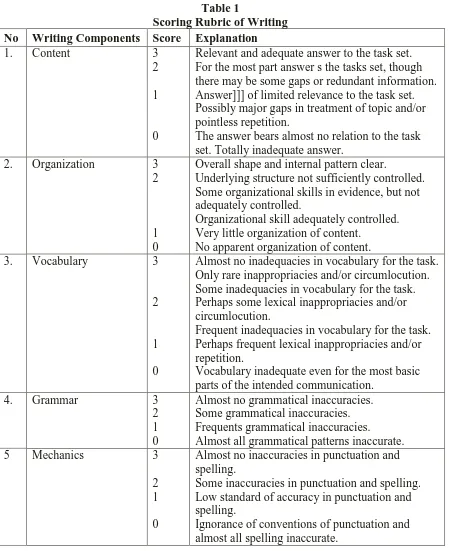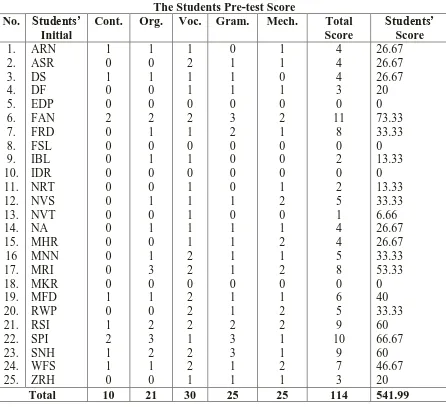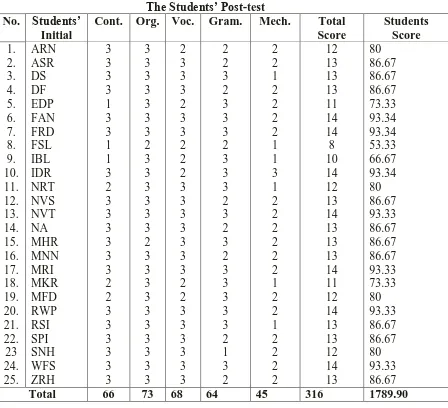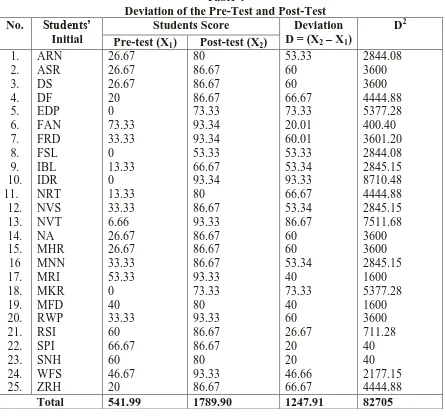e-Journal of English Language Teaching Society (ELTS) Vol. 1 No. 1 2013 – ISSN 2331-1841 1
IMPROVING WRITING SKILL IN WRITING RECOUNT TEXT
THROUGH DIARY WRITING
Vita Ningrum1, Ferry Rita2, Hastini3
Abstract
The research was aimed at proving whether diary writing is effective to
improve students’ skill in writing recount text or not. The research was pre -experimental research design. The population of this research was the tenth grade students at SMA Alkhairaat Kalukubula and the sample was class XA. The number of the sample was 25 students. The researcher employed cluster sampling and adopted one group pre-test and post-test design. The pre-test was used to measure the students’ skill in writing recount text before treatment, and post-test was used to measure the students’ skill after the treatment. Based on the result of both tests, the researcher found that the t-counted was 8.56. The level of significance counted is set up at 0.05 and the degree of freedom (df) of the table is 25 – 1 = 24. The researcher found that t-table was 2.064. It showed that t-counted was higher than the t-table. It means that the hypothesis of this research is accepted. In conclusion, the use of diary writing was effective to improve the students’ skill in writing recount text.
Keywords: Writing Skill; Recount Text; Diary Writing.
INTRODUCTION
Nowadays in Indonesia, all of the students at schools from primary school to
university learn English as a foreign language. The purpose of learning English is that
students can communicate in English both oral form and written one. Especially in senior
high school level, the students learn all English language skills like speaking and writing.
Writing is one of the four language skills. As stated by Finocchiaro and Brumfit (1983:149),
“Writing should reinforce and help extends the listening, speaking, and reading skills”.
Writing as one of the four language skills is part of syllabus in English teaching. It can be
seen from the curriculum 2004, standard competency of senior high school
(Depdiknas:2003) starting the aim of English teaching is “Siswa mampu mengembangkan kemampuan dalam bahasa Inggris dalam bentuk lisan dan tulisan. Kemampuan
1
Email: [email protected] 2
Email: 3
e-Journal of English Language Teaching Society (ELTS) Vol. 1 No. 1 2013 – ISSN 2331-1841 2 berkomunikasi meliputi mendengarkan (Listening), berbicara (Speaking), membaca
(Reading), dan menulis (Writing).”
From the statement above, the researcher concludes that writing can support the
others language skills. It means that writing is a complex domain to learn and to teach
because it requires many skills. Before doing and making a good writing, the students need
to gather much information by listening to other people, doing discussion with others, and
reading more books. By writing, the students can deliver their messages to their readers.
To deliver the message, the students have to produce a text by using English. They
have to write about what they think in their mind and state it on a piece of paper by using
correct procedure. It is supported by Meyers (2005:2) who defines:
Writing is a way to produce language you do naturally when you speak. Writing is speaking to other on paper – or on a computer screen. Writing is also an action – a process of discovering and organizing your ideas, putting them on a paper and reshaping and revising them.
Since writing needs procedure and organization, writing deals with mixture of idea,
vocabulary, and grammar. Harmer (2004) states that making good writing is more complex
than producing speaking. Different from speaking, writing is more difficult to acquire
because there are many aspects related to writing which need to be mastered, such as
organization, mechanics, and grammar. Writing involves more than just producing words
and sentences, but in writing activity the students should be able to combine words and
sentences grammatically into written text. There are many kinds of written text. One of
them is recount text.
Recount is a text that retells events or experiences in the past (Astrid,2010). Its
purpose is either to inform or to entertain the audience. It is similar to narrative text that also
retells an event or an action happened in the past time. Yet, the difference is that narrative
text retells about a story that happened in the past and has not been proved while recount
text retells about that has been proved.
According to Sugeng and Zaimah (2007:44), the characteristics of recount text are
listed below:
1. Recount has a social function of retelling events for informing or entertaining. 2. It is organized chronologically and is built of three elements.
a. Orientation: tells who were involved in the story, when, where, and why the story happened.
b. Events: tells what happened in chronological order. c. Re-orientation: concludes the experience.
3. Language features of recount.
e-Journal of English Language Teaching Society (ELTS) Vol. 1 No. 1 2013 – ISSN 2331-1841 3 b. The use of action verbs. (e.g: went, run, played)
c. The use of past tense. (e.g: we went for a trip to zoo) d. The use of time conjunction. (e.g: that, first, next, then)
e. The use of adverbs and adverbs of phrases. (e.g: in my house, two days ago, slowly)
f. Use adjectives. (e.g: beautiful, slow)
From the explanation above, the researcher concludes that recount text is a kind of a story
that retells us about an event, an experience, or an action that happened in the past and it has
been proved the truth. It is the unfolding sequence of events over time, and the purpose is to
tell what happened. It begins by telling the reader who was involved, where the event took
place and when it happened. Related to the purpose of telling the past event, past tense must
be utilized in recount text.
Relating to recount text, diary writing is one of media in teaching writing. By diary
writing, the students are free to express their ideas, experiences, activities that have
happened in their life. The advantages of diary writing in teaching writing recount text are
the students can apply the use of simple past tense in context, and they can organize their
ideas by using correct grammar, in this case simple past tense, good mechanics, and rich
vocabulary. Diary writing has a lot of fun, and can be adapted to a variety of writing
experiences.
The tenth grade students at SMA Alkhairaat Kalukubula faced some problems
relating to their writing. Here students could not develop their ideas, they did not master the
use of grammatical sentence well, and they are lack of vocabulary. Those were the crucial
things that they cannot master well. The teachers have to give support and guidance to
improve their writing skill. To help the students to improve their writing skill, the teacher
should apply a good medium. A good medium in teaching writing could influence students’
writing skill. There are many media that could be used in teaching and learning process.
One of the media is diary writing in which the teacher would show the students the example
of a diary, and also the teacher could ask the students to identify the tenses used on the
diary. It will help students to warm up and to organize students’ ideas. A teacher of English
plays an important role in teaching writing in order to improve students’ writing skill. She
or he needs to train, motivate, and help the students very often if they found difficulties in
writing.
Based on the problems above, the researcher focused on the students’ problem in
how to develop the idea by using grammatical sentence and mastering the vocabulary
e-Journal of English Language Teaching Society (ELTS) Vol. 1 No. 1 2013 – ISSN 2331-1841 4 the ideas is asking them to start their writing by expressing their feelings, thoughts, ideas,
experiences, and so on that they face in their daily life. This can help the students to develop
their ideas. It is assumed that this way can be adopted by the students to encourage and to
accustom them to write whatever they want to write.
The researcher chose the tenth grade students at SMA Alkhairaat Kalukubula as the
sample of this research because she wanted to help them to solve their problems in writing.
Besides, the researcher also wanted to prove whether students’ skill in writing recount text,
covering content, organization, grammar, vocabulary, and mechanics through diary writing
could be improved or not. Then, the researcher formulated the problem statement as
follows: Can the use of diary writing improve writing recount text of the tenth grade
students at SMA Alkhairaat Kalukubula? It is to verify that diary writing can improve the
writing recount text of the tenth grade students at SMA Alkhairaat Kalukubula.
METHODOLOGY
In conducting this research, the researcher applied pre-experimental research design.
It is only one group. This group was given treatment as seen in the formula by Arikunto
(2010:124) as follows:
O1 X O2
Where :
O1 : Pre-test X : Treatment O2 : Post-test
In this research, the researcher took one group as sample and it was given pre-test
and post-test. The pre-test was conducted to know the students’ basic knowledge while the
post-test was conducted to know the improvement of their skill after the treatment. The
population of this research was the tenth grade students at SMA Alkhairaat Kalukubula
consisting of 2 classes. Each class consisted of 25 up to 27 students. The total number of the
students was 52. Sample is a small part of population. Arikunto (2010:118) states “Sampel
adalah bagian dari jumlah dan karakteristik yang dimiliki oleh populasi tersebut.” In
selecting the sample, the researcher applied a cluster sampling. First, the researcher wrote
the name of the class in two pieces of paper. Second, the researcher folded them and put
them in a glass. Third, the researcher shook the glass and the paper which fell would be the
e-Journal of English Language Teaching Society (ELTS) Vol. 1 No. 1 2013 – ISSN 2331-1841 5 variables: dependent and independent variable. The dependent variable was the students’
writing skill in writing recount text and independent variable was the use of diary writing.
Instruments are the tools or aids which are used by researcher in collecting data. In
this research the researcher used only one test instrument: pre-test and post-test. Pre-test
was given before treatment while post-test was given after the treatment. Both tests were
expected to measure the students’ improvement in writing skill and to know the
effectiveness of diary writing as a medium was given. Pre-test was done by the students
before treatment. It tested the students’ skill in writing recount text. In scoring each item of
writing recount text the researcher used the scoring procedures for writing assessment as
e-Journal of English Language Teaching Society (ELTS) Vol. 1 No. 1 2013 – ISSN 2331-1841 6 Table 1
Scoring Rubric of Writing No Writing Components Score Explanation
1. Content 3
2
1
0
Relevant and adequate answer to the task set. For the most part answer s the tasks set, though there may be some gaps or redundant information. Answer]]] of limited relevance to the task set. Possibly major gaps in treatment of topic and/or pointless repetition.
The answer bears almost no relation to the task set. Totally inadequate answer.
2. Organization 3
2
1 0
Overall shape and internal pattern clear.
Underlying structure not sufficiently controlled. Some organizational skills in evidence, but not adequately controlled.
Organizational skill adequately controlled. Very little organization of content.
No apparent organization of content.
3. Vocabulary 3
2
1
0
Almost no inadequacies in vocabulary for the task. Only rare inappropriacies and/or circumlocution. Some inadequacies in vocabulary for the task. Perhaps some lexical inappropriacies and/or circumlocution.
Frequent inadequacies in vocabulary for the task. Perhaps frequent lexical inappropriacies and/or repetition.
Vocabulary inadequate even for the most basic parts of the intended communication.
4. Grammar 3
2 1 0
Almost no grammatical inaccuracies. Some grammatical inaccuracies. Frequents grammatical inaccuracies.
Almost all grammatical patterns inaccurate.
5 Mechanics 3
2 1
0
Almost no inaccuracies in punctuation and spelling.
Some inaccuracies in punctuation and spelling. Low standard of accuracy in punctuation and spelling.
Ignorance of conventions of punctuation and almost all spelling inaccurate.
After doing pre-test, the researcher treated them in order to improve student’s skill
in writing recount text. The treatment was conducted for eight meetings. After conducting
the treatment, the researcher gave post-test to know whether the students’ skill in writing
e-Journal of English Language Teaching Society (ELTS) Vol. 1 No. 1 2013 – ISSN 2331-1841 7 To know the ability of the students, the researcher firstly computed the individual
score by using formula recommended by Arikunto (2006:276):
∑ = � � 0
Where :
Σ = Standard Score
X = Sum of correct answer N = Maximum score 100 = Fixed score
The researcher calculated the mean score of students in each test. Then the
researcher computed mean deviation between pre-test and post-test, she employed the
formula recommended by Arikunto (2006:307) as follows:
�= Ʃ�
Where :
Md = Mean score
∑d = The total score of deviation. N = Number of students
Next, the researcher computed the square deviation by using formula recommended
by Arikunto (2006:308) as follows:
�2� = �2− (∑ �) 2
Where:
∑x2d = the sum of squared deviation
∑2
d = the sum of deviation
In order to know whether the students’, score of pre-test and post-test has significant difference or not, the researcher used the formula recommended by Arikunto (2010:349) as
follows:
�= �
∑ � � ( − )
Where :
t = t-test score
Md = mean from pre-test and post-test
e-Journal of English Language Teaching Society (ELTS) Vol. 1 No. 1 2013 – ISSN 2331-1841 8 RESULT
The researcher conducted the pre-test on May 30th, 2013. The result of pre-test was
presented in the following table:
Table 2
The Students Pre-test Score No. Students’
Based on the table above, the highest score was 73.33 and the lowest score was 0.
After getting the total score of the students, the researcher computed the students’ mean
score by using the formula below:
M = ∑�
= 541.99 25
= 21.68
e-Journal of English Language Teaching Society (ELTS) Vol. 1 No. 1 2013 – ISSN 2331-1841 9 Table 3
The Students’ Post-test No. Students’
After doing the computation, the researcher found that the highest score was 93.33 and the
lowest score was 53.33. The writer then calculated the mean score by using the formula
The students’ mean score of post-test was 71.60.
From the calculation above, it showed that there were different results in writing
recount text between the students’ mean score in pre-test and post test. The students’ mean score in post-test (71.60) was higher than students mean score in pre-test (21.68). Those
e-Journal of English Language Teaching Society (ELTS) Vol. 1 No. 1 2013 – ISSN 2331-1841 10 After getting the mean score of pre-test and post-test, the researcher continued to
count the mean deviation and the square deviation. The result is presented in the following
table:
Table 4
Deviation of the Pre-Test and Post-Test No. Students’
Initial
Students Score Deviation
D = (X2– X1)
After computing the deviation score between pre-test and post-test, the researcher computed
the mean deviation of the students’ score that presented below:
M d = ∑�
= 1247 .91 25
= 49.92
After getting the mean deviation, the researcher computed the sum of square deviation as
e-Journal of English Language Teaching Society (ELTS) Vol. 1 No. 1 2013 – ISSN 2331-1841 11
∑x2
d = ∑�2− (∑d)2
= 82705−(1247 . 91)2 25
= 82705−1557279 . 36 25
= 82705−62291. 17
= 20413.83
After having the sum of square deviation, the researcher needed to analyze the data
statistically in order to know the significant difference of the pre-test and the post-test by
using t-test formula as shown below:
t = �
∑�( 2−d1)
t = 49.91
20413 . 83 25 (25−1)
t = 49.91
20413 . 83 600
t = 49.91 34.02305
t = 49.91 5.83
t = 8.56
From the above computation, the researcher found that the significant difference between
the result of students’ pre-test and post-test was 8.56.
DISCUSSION
Related to the result of students' pre-test, none of the students got the highest score.
The standard score at the school was 60. The percentage of students who got score lower
than 60 was 84%. It means that only 4 students (16%) got score more than 60. In pre-test,
there were 1 student who got the highest (4%) and there were 3 students who got the lowest
(12%). In doing the pre-test, the students did not know well how to write about recount text
paragraph.
To solve the problem, the researcher applied diary writing in order to improve
students’ skill in writing recount text. In the first treatment, the researcher asked the
students to write about something happened to them into a recount text paragraph. It was
e-Journal of English Language Teaching Society (ELTS) Vol. 1 No. 1 2013 – ISSN 2331-1841 12 that, the researcher explained about simple past tense then generic structure of recount text.
Also, the researcher showed the example of diary writing in order to make the students
know how to start writing about something that they experienced. For each meeting, the
researcher asked them to write recount text paragraph based on the generic structure of
recount text, it aimed at improving their writing skill through diary writing.
After conducting the treatment, the researcher gave post-test through diary writing,
she found that students already understood how to write recount text paragraph. In post-test
the percentage of students who got the highest score was 84%. There were 7 students (28%)
who got the highest, and there was only 1 student (4%) who got the lowest. In short,
students’ score was increased from the pre-test to the post-test. By comparing the result of pre-test and post-test, the researcher concluded that the use of diary writing in writing
recount text was effective because there was a progress in students' score. There was also a
significant progress by comparing the result of t-counted to t-table.
CONCLUSION AND SUGGESTIONS
After conducting the treatment for eight meetings, the researcher found that the use
of diary writing can improve students’ writing skill in recount text. It is proven by the result
of tcounted (8. 56) was greater than ttable (2.064). It means that diary writing is an effective
media of teaching recount text paragraph.
In order to develop the English teaching quality, the researcher would like to share
the suggestions for the development of teaching and learning writing especially writing
recount text. First, the students should be given more exercises concerning to the material
about the past tense. Furthermore, they can write in the form of recount text paragraph using
varied words in good construction. Second, the teachers should provide the students a good
medium so that the students feel much comfortable when they are asked to write in English.
Third, in teaching writing, the teachers should explain to the students about the rule of the
media given. Therefore, if students find difficulties in understanding the instruction given,
they should ask the teacher for clearer explanation.
REFERENCES
Arikunto, S. (2006). Prosedure Penelitian: Suatu Pendekatan Praktik. Jakarta: PT Asdi Mahasatya.
e-Journal of English Language Teaching Society (ELTS) Vol. 1 No. 1 2013 – ISSN 2331-1841 13 Astrid. (2010). Improving Writing Recount Text through Personal Journal. Unpublished:
Tadulako University Palu.
Departemen Pendidikan Nasional. (2003). Kurikulum 2004 Standar Kompetensi. Mata
Pelajaran Bahasa Inggris. Sekolah Menengah Atas. Jakarta.
Finocchiaro and Brumfit. (1983). The Functional Notional Approach. Oxford University. Inc. New York.
Harmer, J. (2004). How to Teach Writing. Essex: Longman Group. Ltd.
Meyers, A. (2005). Gateways to Academic Writing: Effective Sentences, Paragraphs and
Essays. New York: Pearson Education, Inc.



